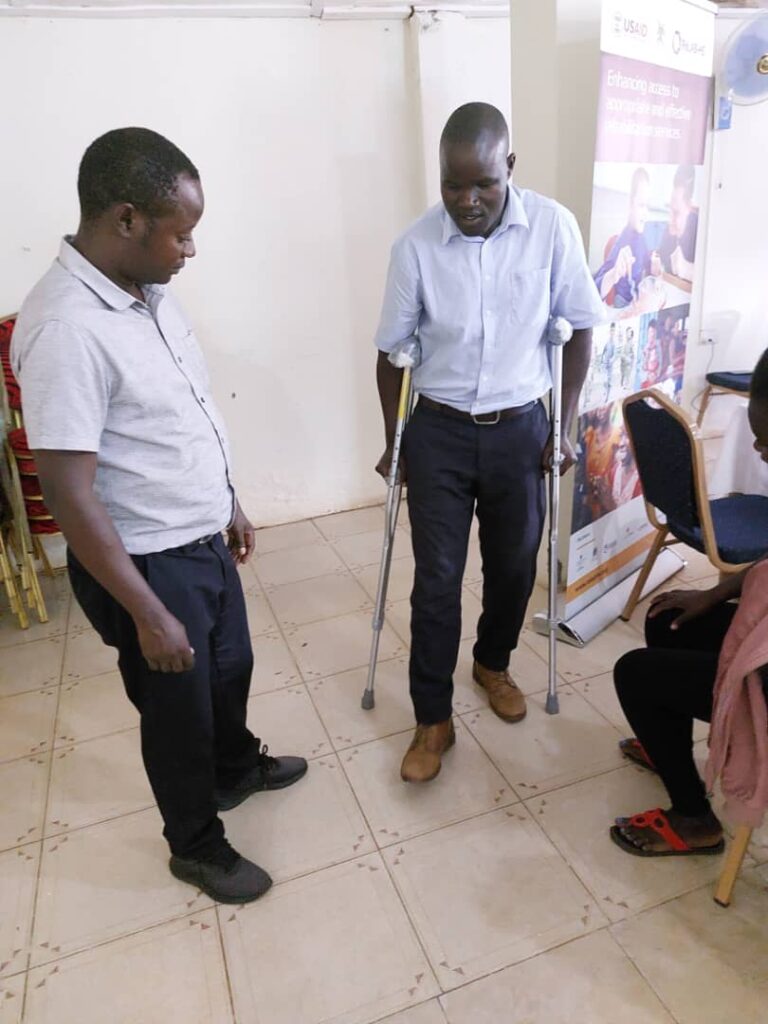
By Lamech Emoru and Maria Toro for ReLAB-HS
The World Health Organization (WHO) estimates that about 2.5 billion people today need one or more assistive products, such as walking canes, crutches, wheelchairs, and hearing aids. However, in some countries, only 3 percent of people have access to them. Limited available services with personnel trained in the provision of assistive technology (AT) and limited availability of quality assistive products, among other challenges, have hindered access for many.
In Uganda, AT services in the public sector are provided by specialized hospitals (regional referral hospitals) that are staffed with rehabilitation professionals and have facilities such as orthopedic workshops, which make, fit, and repair assistive products according to clients’ needs. Primary health care (PHC) facilities, which are located closer to communities than regional referral hospitals, do not currently employ rehabilitation professionals and do not have the mandate to provide any rehabilitation services inclusive of AT.
Learning, Acting, and Building for Rehabilitation in Health Systems (ReLAB-HS) collaborates with local public and private stakeholders to support the integration of rehabilitation into health systems to bring quality rehabilitation services inclusive of AT closer to communities. As part of this effort, we are working to test service delivery models that engage PHC providers to identify rehabilitation and AT needs, as well as provide simple rehabilitation and AT services.
To support this approach, by engaging rehabilitation providers, we are training non-rehabilitation providers at the PHC level on the provision of simple assistive products. As part of our commitment to sustainability, ReLAB-HS adapts available, high-quality technical resources to local contexts and promotes their use by local stakeholders. As such, we use the WHO’s Training on Assistive Products (TAP), an open-source online learning platform, to train providers.
How did we do it?
To guide a context-appropriate approach in Uganda, ReLAB-HS worked with medical and rehabilitation providers, managers, and service users from four districts (Lira, Gulu, Iganga, and Mayuge) to co-design a new service delivery model. With an emphasis on strengthening providers’ skills, the improved model includes practical, feasible interventions to support integrating rehabilitation services into PHC-level services, including mechanisms to support the provision of simple AT services.
We supported 13 local physiotherapists, occupational therapists, and orthpedic technologists to complete the TAP modules on the provision of simple assistive products, including walking aids and toilet and shower chairs. The training updated the rehabilitation providers on current trends and oriented them to the training content.
Carrying this new knowledge forward, these rehabilitation providers participated in an in-person practical training supported by ReLAB-HS in which they also mentored and supported 25 PHC providers (doctors, clinical officers, nurses, and midwives) in learning to provide AT services appropriate for individuals’ needs. These services include individual assessment and selection of the appropriate assistive product(s), fitting, training users on proper use of the product(s), and following-up with individuals who received services.
Equipped with new skills and motivated to act
As a result of this training, PHC providers now have the skills to recognize those who may benefit from AT services and to provide simple assistive products appropriate for individuals’ needs. Additionally, they know when, how, and where to refer individuals for more complex cases, supporting the coordination of care for individuals who require additional services.
The AT training left both PHC providers and rehabilitation professionals feeling motivated by their new knowledge and skills to provide services that are greatly needed in their communities. The discussions depicted situations that the PHC providers experienced in their daily practice, validating their struggles to provide services. With useful solutions now available to them, participants were eager to put their new skills into practice.
A clinical officer who had taken it upon himself to prescribe crutches as part of his practice was thrilled with his expanded skillset. He reflected on the impact the training will have on his work and on individuals in need of services, sharing, “I have been referring would-be crutch users to carpenters who have workshops situated a short distance from the health unit. However, with the new knowledge I have gained, I will be able to give proper guidance on measurements of the crutches. This will guide carpenters to be able to provide the right size of crutches with all the accessories and guide them to provide the right product to the patients.”
What’s next?
ReLAB-HS continues to collaborate with these four districts to monitor how the services are going, including determining ways to maintain a steady supply of quality assistive products to be readily available. Additional trainings to cover the provision of other simple assistive products will be implemented, further expanding the skillsets of both rehabilitation and non-rehabilitation providers and improving access at the primary care level.
The TAP is available to anyone who wants to use it! Don’t miss out—it’s available in 14 languages as of the publication of this blog.